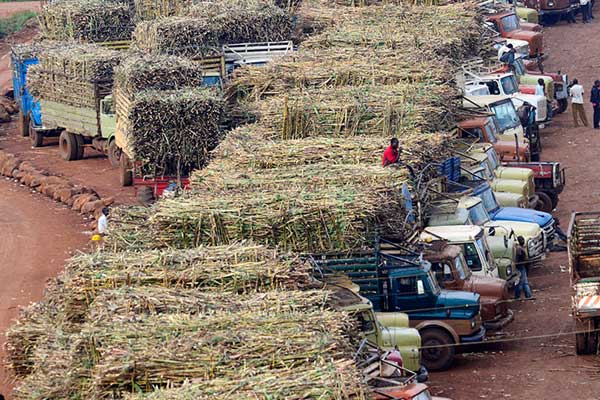Prices of sugarcane have fallen by 80 per cent in last four years

Sugarcane prices have been falling since 2017 rendering the number of people in sugarcane growing subregions income poor. Photo | File
What you need to know:
- The report, which covers the period between 2017 and 2021, indicates that the price of a metric tonne of sugarcanes has in the last four year fallen by close to Shs120,000, which represents a decline of about 80 per cent.
A new study by Economic Policy Research Center has found that prices of sugarcane have been declining at a drastic rate despite an increase in milling factories.
The report, which covers the period between 2017 and 2021, indicates that the price of a metric tonne of sugarcane has in the last four years fallen by close to Shs120,000, which represents a decline of about 80 per cent.
The fall, the report notes, explains poverty levels experienced in the sugarcane growing sub-regions such as Busoga.
The decline comes at a time when there has been a fast-paced increase in the number of sugar millers, supported by improved supply and good government support.
Farmers are also facing increasing stockpiles resulting from a ban by Kenya recently, which stopped exports of the commodity into the country.
The sugar subsector has been growing since 2011 after government issued a number of new licenses, which increased active producers from just four in the 90s to more than 13 factories that are either in the final stage or already at production level.
Seven others were issued licenses but are yet to start production.
According to the report a metric tonne of sugarcanes, which was sold for Shs180,000 in 2017 has been declining over time, falling to Shs120,000 in 2018, before declining further to an average of Shs110,000 in 2019.
The decline has since worsened to an average of Shs94,000 in 2020, before falling further to the current Shs60,000, the report noted.
“The low cane prices have made [people in parts of] eastern and northern Uganda where sugarcane growing is fast expanding to be the poorest and such areas lag behind in terms of security,” the report noted, indicating a serious development challenge in which government must intervene.
The report also shows that the slowdown in poverty reduction and worsening food security in sugar growing sub-regions, questions the capacity of existing governance structures to deliver inclusive economic growth for populations deriving a livelihood from sugarcane growing.
The report cites Busoga, which is a major sugarcane growing sub-region, as home to majority of income poor Ugandans. At least more than 1.2 million and nearly 0.4 million people are classified as poor and food poor, respectively, according to the report.
According to the 2019/20 Uganda National Household Survey, data indicates that the number of poor Ugandans had increased from eight million to 8.3m people with majority of these living in Busoga, which has a percentage share of 14 per cent.
While releasing the report findings in Kampala last week, Mr Swaibu Mbowa, a senior research fellow at the Economic Policy Research Center, said that although government has responded to institutional needs of the sugar subsector by instituting supportive laws such as the Sugar Act 2020, which regulates sugar production and trading, there has been a low trickledown effect, especially at the farming level.
“What needs to be done is to ensure realisation of socioeconomic transformation of sugarcane growing communities,” he said, adding that government must facilitate inclusive rural transformation by putting in place plans to expand sugarcane growing into a viable commercial activity.
Sugarcanes are also useful in the manufacture of bio fuels, which are regulated under the Ethanol Bio Fuels Act 2018.
Mr Mbowa urged government to eliminate middlemen that sugar millers deploy to frustrate farmers and primary dealers thus failing to benefit directly.
Solution
Speaking at the launch of the study, Trade State Minister David Bahati, said government will in the next five years invest close to Shs1.8b, much of which be used to set up sugar factories in all regions.
“The setting up of sugar industries by government will maintain a level amount of buying sugarcane from farmers so as to avoid current trends of falling prices by private sector players,” he said.
By 2019, sugarcane production had reached 4.89 million tonnes, increasing from 1.75 million tonnes in the 1970s, which indicates an average growth of 3.62 per cent annually.




